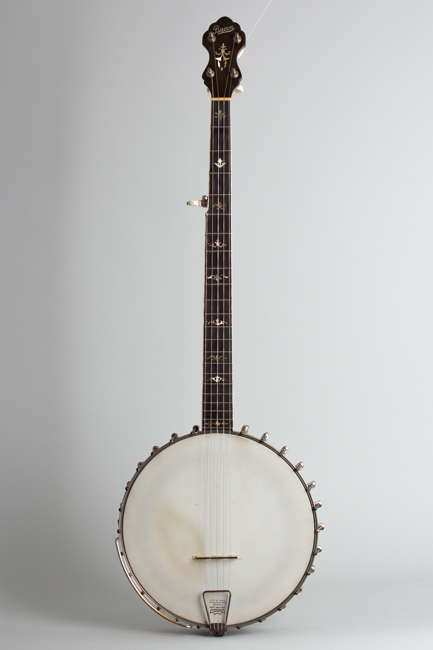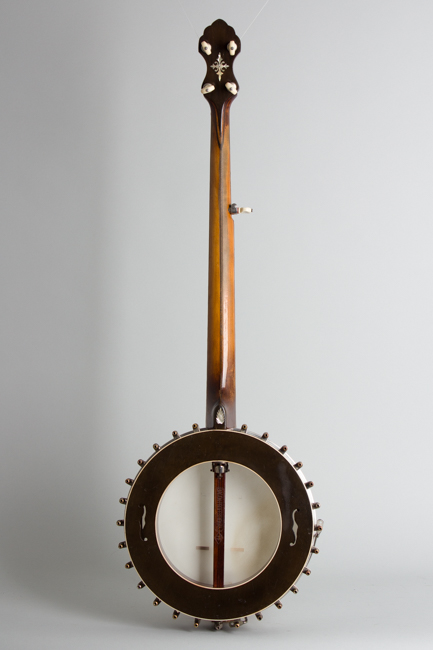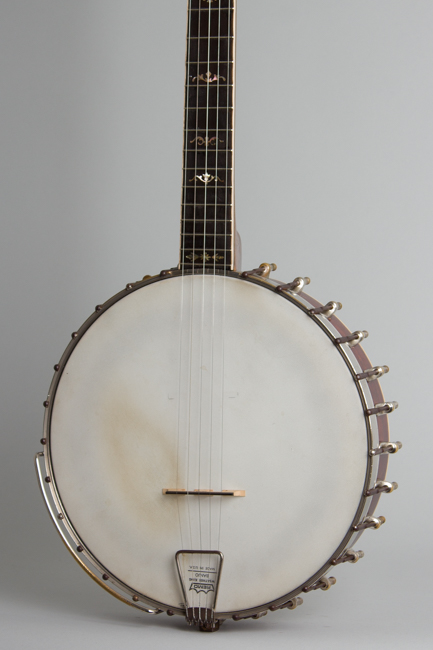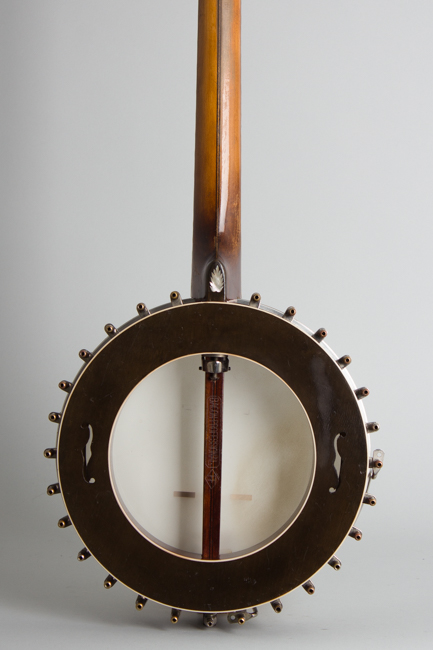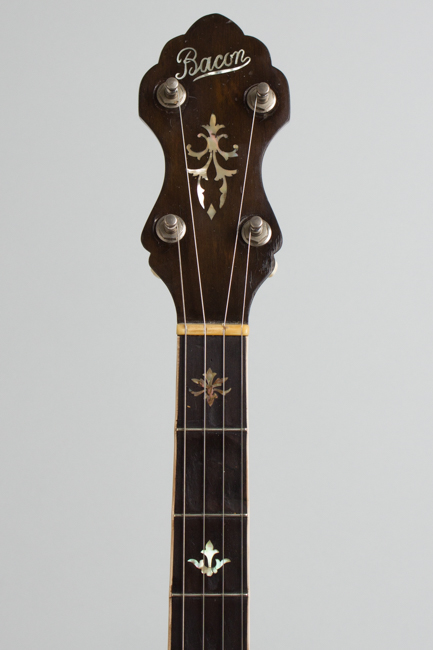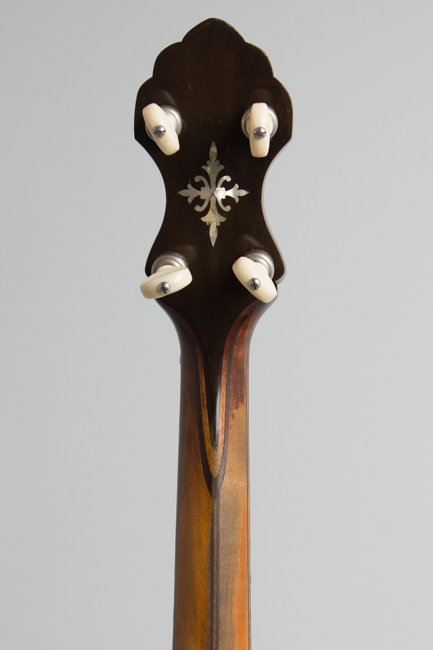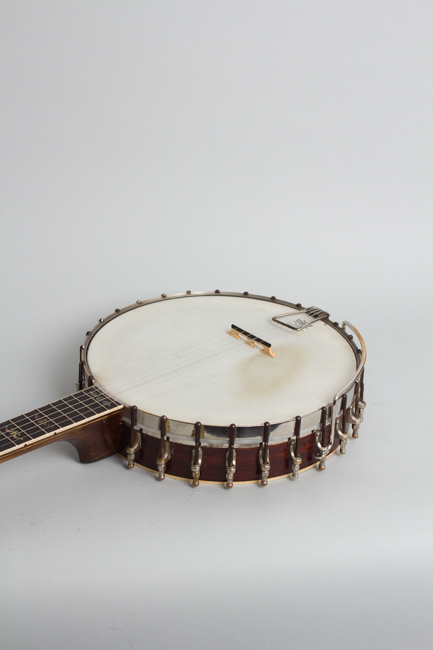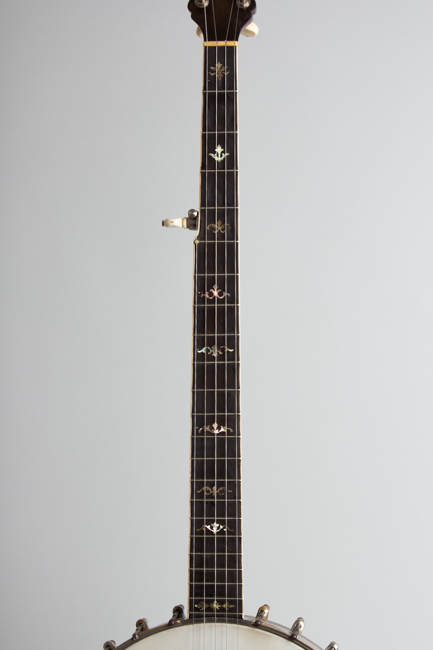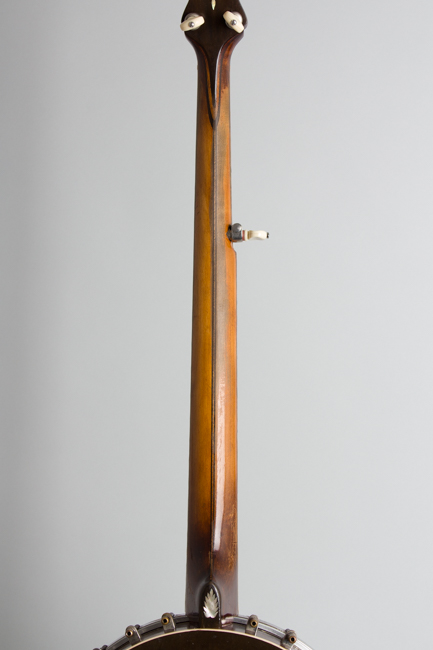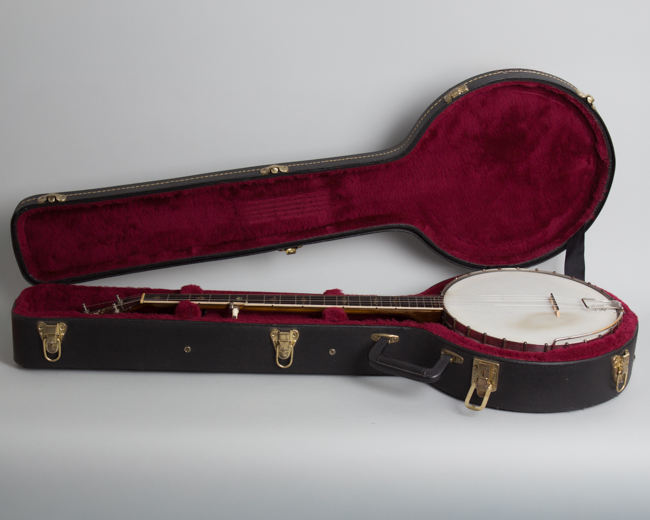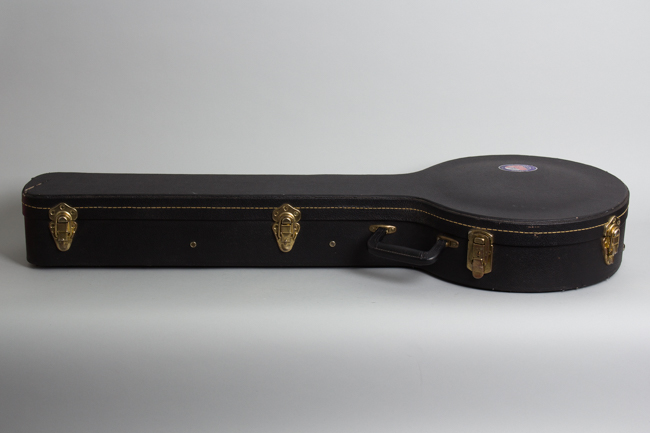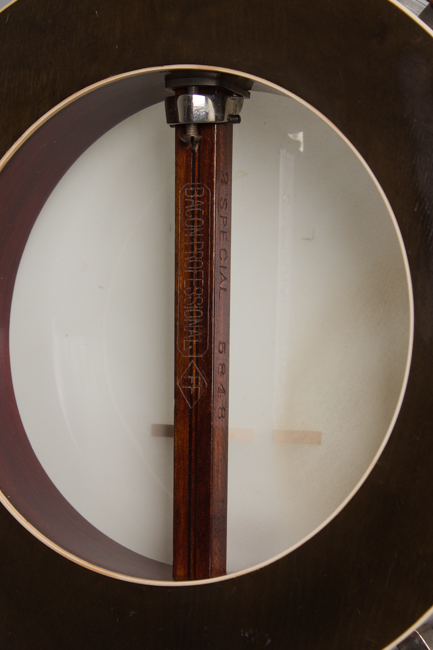Bacon Professional FF #2 Special 5 String Banjo (1920)
This item has been sold.
Item # 12491
Prices subject to change without notice.
Bacon Professional FF #2 Special Model 5 String Banjo (1920), made in Groton CT, serial # 5848, shaded maple finish, laminated maple rim and neck, ebonized fingerboard, black tolex hard shell case.
This very attractive 5-string banjo is a nice example of Fred Bacon's instruments at the dawn of the 1920s, just before David Day became his partner. This Professional Special #2 was sold by the Bacon Banjo company not long after they opened their Groton CT facility, finally doing much of their own work after nearly two decades of subcontracting.
Bacon himself was a leading 5-string banjo stylist in the early 1900s and like several of his peers started designing and selling his own banjos. Originally there was no Bacon factory; the earliest instruments were built by Vega in Boston and later Rettberg and Lange in New York. Like everything Fred Bacon put his name on this is a classy instrument.
The most unique design element of the "FF Professional" is the rim, built around Fred Bacon's patented tone ring and a unique internal resonator system. This consists of a hollow chamber with a substantial air cavity between the inner and outer surfaces. There are just two f-holes on the back of this resonating chamber; earlier versions had soundholes all along the surface. The cupped Bacon tone ring is mounted under the head but not visible.
The #2 was not the high-grade style but still a nicely detailed instrument. The bottom edges of the maple resonator rim are bound in celluloid. The neck is quite fancy, made up of laminated maple with underlaid wood strips down the center and beneath the bound ebonized fingerboard. This, the heelcap and the headstock (front and back) are inlaid with elaborate shaped pearl designs. The neck is fairly slim for the period with a noticeable "V" profile shading to rounder as it approaches the body.
The hardware is good quality and remains original except for all 5 tuners, which are later geared Planets (this banjo originally had non-geared friction tuners). The tailpiece with the unusual wire extension is a unique Bacon fitting; the heavy armrest is a period style but may be a later addition. This is a finely built instrument and a very good sounding 5-string banjo with the unique character of that Bacon internal resonator system. David Day's partnering with Fred Bacon a couple of years later ended the run of these older models, paving the way for the Silver Bells. This is a cool and lovely survivor of the "FF" era just before.
Overall length is 37 3/4 in. (95.9 cm.), 11 5/8 in. (29.5 cm.) diameter head, and 2 3/4 in. (7 cm.) in depth, measured at side of rim. Scale length is 27 1/4 in. (692 mm.). Width of nut is 1 3/16 in. (30 mm.).
Overall this is a nicely preserved instrument showing a decent amount of play wear but no major repairs. The thin original varnish finish has wear overall, mostly small dings, scratches and dents. The back of the neck is worn through down to the wood in several areas, with what looks like some areas affected by moisture at the body end but has little in the way of dings, dents or capo wear. The finish is original except both sides of the headstock have a light clear overspray, probably done when the tuners were changed.
The hardware has general wear to the plating and heavier corrosion in spots; most of the hooks are fairly well rusted and the tailpiece is missing most of its plating. The fingerboard has some light divoting in the lower positions; the frets in that area show some light wear but play fine. The banjo is set up with a plastic head and steel strings, sounds great and plays very well. This is a cool Bacon rarity and a fine, distinctive sounding instrument housed in a later HSC. Overall Very Good + Condition.
This very attractive 5-string banjo is a nice example of Fred Bacon's instruments at the dawn of the 1920s, just before David Day became his partner. This Professional Special #2 was sold by the Bacon Banjo company not long after they opened their Groton CT facility, finally doing much of their own work after nearly two decades of subcontracting.
Bacon himself was a leading 5-string banjo stylist in the early 1900s and like several of his peers started designing and selling his own banjos. Originally there was no Bacon factory; the earliest instruments were built by Vega in Boston and later Rettberg and Lange in New York. Like everything Fred Bacon put his name on this is a classy instrument.
The most unique design element of the "FF Professional" is the rim, built around Fred Bacon's patented tone ring and a unique internal resonator system. This consists of a hollow chamber with a substantial air cavity between the inner and outer surfaces. There are just two f-holes on the back of this resonating chamber; earlier versions had soundholes all along the surface. The cupped Bacon tone ring is mounted under the head but not visible.
The #2 was not the high-grade style but still a nicely detailed instrument. The bottom edges of the maple resonator rim are bound in celluloid. The neck is quite fancy, made up of laminated maple with underlaid wood strips down the center and beneath the bound ebonized fingerboard. This, the heelcap and the headstock (front and back) are inlaid with elaborate shaped pearl designs. The neck is fairly slim for the period with a noticeable "V" profile shading to rounder as it approaches the body.
The hardware is good quality and remains original except for all 5 tuners, which are later geared Planets (this banjo originally had non-geared friction tuners). The tailpiece with the unusual wire extension is a unique Bacon fitting; the heavy armrest is a period style but may be a later addition. This is a finely built instrument and a very good sounding 5-string banjo with the unique character of that Bacon internal resonator system. David Day's partnering with Fred Bacon a couple of years later ended the run of these older models, paving the way for the Silver Bells. This is a cool and lovely survivor of the "FF" era just before.
Overall length is 37 3/4 in. (95.9 cm.), 11 5/8 in. (29.5 cm.) diameter head, and 2 3/4 in. (7 cm.) in depth, measured at side of rim. Scale length is 27 1/4 in. (692 mm.). Width of nut is 1 3/16 in. (30 mm.).
Overall this is a nicely preserved instrument showing a decent amount of play wear but no major repairs. The thin original varnish finish has wear overall, mostly small dings, scratches and dents. The back of the neck is worn through down to the wood in several areas, with what looks like some areas affected by moisture at the body end but has little in the way of dings, dents or capo wear. The finish is original except both sides of the headstock have a light clear overspray, probably done when the tuners were changed.
The hardware has general wear to the plating and heavier corrosion in spots; most of the hooks are fairly well rusted and the tailpiece is missing most of its plating. The fingerboard has some light divoting in the lower positions; the frets in that area show some light wear but play fine. The banjo is set up with a plastic head and steel strings, sounds great and plays very well. This is a cool Bacon rarity and a fine, distinctive sounding instrument housed in a later HSC. Overall Very Good + Condition.
